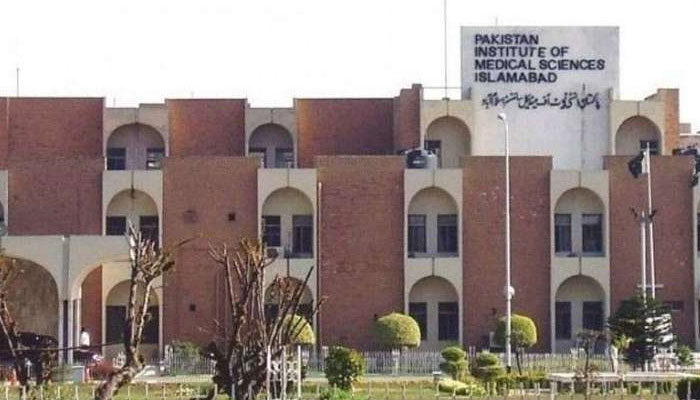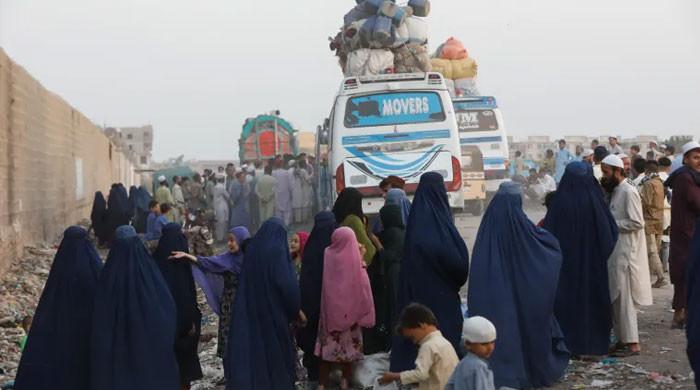Special Report: As patient load increases in Islamabad, hospitals are being tested
Islamabad ranks third among the top-seven cities in terms of COVID-19 deaths per million population
June 06, 2020

ISLAMABAD: Even though Islamabad is not listed among the country’s top-seven cities in terms of the total number of COVID-19 cases and deaths, the city remains conspicuous for reporting the highest number of COVID-19 cases per million population, and the third-highest number of coronavirus induced deaths per million population in the country, ‘The News’ has reliably learnt.
According to officially documented data exclusively available to this scribe, Islamabad had—as of June 3—reported 2,610 cases per million population. Although seemingly an insignificant number, the fact that a majority of the county’s overall population—the residents of Islamabad being no exception—is petrified by the thought of self-volunteering for testing and resultantly remain undiagnosed, adds a menacing dimension to these trends.
Islamabad also ranks third among the top-seven cities in terms of COVID-19 deaths per million population. The city reported 26 deaths/ million as of June 3, preceded only by Malakand with 31 deaths/million and Peshawar topping the list with 50 deaths/million. Karachi ranks 4th with 25 deaths/million, followed by Rawalpindi, Lahore, and Swat, with 23, 19, and 19 deaths per million, respectively.
With 21,000 tests per million, Islamabad is also way ahead of any other city in terms of the number of tests being conducted. “This is one of the biggest reasons for higher number of cases. When we don’t test, we don’t get numbers, as has been the case in Punjab,” remarked a data analyst. Moreover, the Islamabad Capital Territory (ICT) is also learnt to have embarked on a seroprevalence survey for identification of the actual number of residents exposed to COVID-19. The survey is based on antibody testing in blood. The total number of tests undertaken in Islamabad exceeded 43,500 on June 4 as the number of confirmed cases in the city touched 3,544, with 3,201 active cases, 302 recoveries, and 41 deaths as of June 4. Weekly data of confirmed cases in Islamabad also depicts a progressive increase with enhancement of the country’s testing capacity. According to available data, Islamabad reported four confirmed cases during the week March 10-16; 11 cases during March 17-23, and 39 cases during March 24-31. The first week of April witnessed 38 cases—one short of the previous week’s 39. This has thus far been the only week when the number declined, although inconsequentially. Fifty-three confirmed cases were reported during April 8-15, followed by 69 during April 16-23 with the addition of 16 new cases. The number of cases then substantially increased from 69 to 129 during April 24-30, with another 86 cases the following week taking the total to 215 during May 1-7. In the three weeks that followed, the number of cases increased from 363 (May 8-15) to 671 (May 16-23) and then 997 during the last week of May.
A province-wise breakup of critical beds’ allocation and occupancy (with oxygen) for Covid-19 patients, as of June 3, portrays Islamabad as being enviably self-sufficient with only 14 of 248 allocated beds occupied. These numbers defy facts as PIMS alone had 58 Covid-19 admissions on June 4 alone—13 of them on ventilators.
As far as ventilator utilisation for COVID-19 patients is concerned, only 12 (13%) of the 92 allocated ventilators are currently being utilised by patients admitted in Islamabad’s hospitals while 80 lay vacant.
According to national data, the number of patients on oxygen has always been in excess of those requiring ventilatory support. In the last one month, for instance, the number of patients on oxygen rose from 111 on May 3 to 606 on June 3, while those on ventilators skyrocketed from 36 on May 3 to 231 on June 3.
Frontline healthcare providers and workers affected by COVID-19 in Islamabad, as of June 3, comprise 106 doctors, 50 nurses, and 61 paramedics and other staff. At the national level, 2,561 healthcare personnel had tested positive as of June 3; these comprised 1,510 doctors, 352 nurses, and 699 health staff, with 937 recoveries constituting 37% of the total.
Hospital-based data acquired by ‘The News’ show that the Pakistan Institute of Medical Sciences (PIMS), which is all set to become the only tertiary care government hospital dedicated to the management and treatment of Covid-19 patients in Islamabad, is equipped with 85 ventilators in its different ICUs (Medical ICU, Surgical ICU, Coronary Care ICU, Pediatric ICU, Neonatal ICU, and MCH Centre). Of the total ventilators, 26 are exclusively reserved for Covid-19 patients, 13 are currently in use, and an equal number is vacant. Two of the vacant ventilators are reserved for pediatric patients. According to the hospital’s Joint Executive Director Dr. Minhaj-Us-Siraj, PIMS houses 45 High Dependency Unit (HDU) beds for Covid19 patients, of which 28 were occupied and the remaining 17 were vacant as of June 4. All 30 isolation beds at PIMS are also occupied by COVID-19 patients. Even though initial capacity-related issues have been overcome, some limitations are resurfacing with increasing patient load. The Deputy Director of the evening shift at PIMS Dr. Fahim hoped that the NCOC-devised Resource Management System, which will offer real time data regarding availability of beds, ventilators, and hospital-based facilities for COVID-19 patients, is quickly operationalised so that patients who cannot be accommodated at PIMS at a given time are referred to some other facility.
While the management and treatment of COVID-19 patients is itself grueling and arduous, health personnel are beset with a variety of additional challenges. The in-charge nurse at PIMS, for instance, termed acute shortage of nursing and support staff in the Covid-19 ICU as disconcerting and feared that the health human resource crisis in Islamabad would only exacerbate in the weeks and months ahead.
“We currently have only 18 ICU nurses performing duties in three shifts (6 nurses per shift), as against a requirement of 60 nurses (20 per shift) per day,” the ICU nurse pointed out, tabling her wish list. Immediate measures, nonetheless, must be instituted to overcome the widening human resource gap as the number of cases increases. Moreover, there are no replacements when nurses fall ill or are too exhausted to serve. “Should symptoms pop up, they take relevant meds, gargle, and return to their patients in the hope of being replaced, which is seldom the case,” said the in-charge nurse.
At Polyclinic, doctors and nurses claimed facing two types of risks—the risk of acquiring infection from Covid-19 patients, and the risk of physical altercations by attendants. “Forty health personnel in Polyclinic and around 90 in PIMS have tested positive thus far. With a growing number of medics acquiring the infection, the health system’s capacity to tackle this emergency has already begun to dwindle,” stated a doctor (requesting anonymity) working in Polyclinic’s Coronavirus Isolation Ward.
In a related development, a policy decision has reportedly been taken to disband the 12-bedded Coronavirus Isolation Ward of Polyclinic and to shift all confirmed patients to PIMS. Verbal instructions against admission of new COVID-19 patients at Polyclinic were issued on June 4 although an official notification is still awaited. With two COVID-19 patients discharged on June 4, only eight admissions now remain in the said hospital.
The Capital Hospital’s 20-bedded Corona Isolation Ward is equipped with four ventilators. Six COVID-19 patients were admitted at the hospital as of June 4—almost all of them are being managed for comorbid conditions. Critically ill patients requiring HDU beds are referred to PIMS. The hospital reported ample supplies of PPEs and medicines following some hiccups in the initial days of the epidemic. Shortage of doctors, nurses, paramedics, technicians, and staff is a key constraint, which is expected to be overcome with 200 recruitments (including 50 doctors and nurses each) for which an advertisement would be afloat within the next couple of days, ‘The News’ reliably learnt.
The Federal General Hospital (FGH)—which was envisaged as a tertiary care facility at the time of its establishment—is ill-equipped to accommodate COVID-19 patients in the event of a larger medical emergency. The hospital currently has a 4-bedded ICU only. “We referred around 20 suspected patients to PIMS during the last one week,” the Deputy Director of FGH Dr. Mir Hassan confirmed. Responding to a query about availability of ventilators, he said, “Secondary care hospitals like ours are not supposed to have ventilators.” The FGH currently has only two vents—both non-functional.
With reference to capacity-building of health professionals, Dr. Shahzad Ali Khan, Head of the Public Health Department of the Health Services Academy (HSA) shared that HSA has initiated a series of ‘Basic Assessment and Support in Intensive Care’ (BASIC) trainings on ICU care in several cities including Islamabad, Karachi, Lahore, Quetta, Gilgit-Baltistan, and Nawabshah. The curriculum of the trainings, which will be imparted by CPSP-certified intensivists, has been adopted from the Chinese University of Hong Kong. The course is meant for ICU doctors, nurses, and technicians of all 600 government and private hospitals listed as COVID-19 facilities by the National Disaster Management Authority.
As the grip of COVID-19 tightens around Islamabad, it is the shortage of doctors, nurses, technicians, and support staff in the city’s public sector hospitals that remains a key concern. “Our predicament should be a clarion call for the government—how long will it be before we too succumb to mounting pressure,” was the overriding takeaway apprehension expressed by medics and staff alike during interviews with this scribe.











